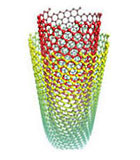Revolutionary Nanotech Water Desalination Membrane
 California, USA - Researchers at the UCLA Henry Samueli School of Engineering and Applied Science have announced they have developed a new reverse osmosis (RO) membrane that promises to reduce the cost of seawater desalination and wastewater reclamation.
California, USA - Researchers at the UCLA Henry Samueli School of Engineering and Applied Science have announced they have developed a new reverse osmosis (RO) membrane that promises to reduce the cost of seawater desalination and wastewater reclamation. To see how Klean Industries is developing Nano Carbon Technologies please click here.
Reverse osmosis desalination uses extremely high pressure to force saline or polluted waters through the pores of a semi-permeable membrane. Water molecules under pressure pass through these pores, but salt ions and other impurities cannot, resulting in highly purified water.
To view a report on how nanocarbons can be used for the filteration of water and waste water and its benifits please click here.
The new membrane, developed by civil and environmental engineering assistant professor Eric Hoek and his research team, uses a uniquely cross-linked matrix of polymers and engineered nanoparticles designed to draw in water ions but repel nearly all contaminants. These new membranes are structured at the nanoscale (the width of human hair is approximately 100,000 nanometers) to create molecular tunnels through which water flows more easily than contaminants.
Unlike the current class of commercial RO membranes, which simply filter water through a dense polymer film, Hoek’s membrane contains specially synthesized nanoparticles dispersed throughout the polymer - known as a nanocomposite material.
“The nanoparticles are designed to attract water and are highly porous, soaking up water like a sponge, while repelling dissolved salts and other impurities,” Hoek said. “The water-loving nanoparticles embedded in our membrane also repel organics and bacteria, which tend to clog up conventional membranes over time.”
With these improvements, less energy is needed to pump water through the membranes. Because they repel particles that might ordinarily stick to the surface, the new membranes foul more slowly than conventional ones. The result is a water purification process that is just as effective as current methods but more energy efficient and potentially much less expensive. Initial tests suggest the new membranes have up to twice the productivity — or consume 50 percent less energy — reducing the total expense of desalinated water by as much as 25 percent.
A critical limitation of current RO membranes is that they are easily fouled — bacteria and other particles build up on the surface and clog it. This fouling results in higher energy demands on the pumping system and leads to costly cleanup and replacement of membranes. Viable alternative desalination technologies are few, though population growth, over-consumption and pollution of the available fresh water supply make desalination and water reuse ever more attractive alternatives.
With his new membrane, Hoek hopes to address the key challenges that limit more widespread use of RO membrane technology by making the process more robust and efficient.
Hoek is working with NanoH2O, LLP, an early-stage partnership, to develop his patent-pending nanocomposite membrane technology into a new class of low-energy, fouling-resistant membranes for desalination and water reuse. He anticipates the new membranes will be commercially available within the next year or two.
The first viable reverse osmosis membrane was developed and patented by UCLA Engineering researchers in the 1960s. The school also is home to the Water Technology Research Center, founded in 2005, which seeks to advance the state of desalination technology and to train the next generation of desalination experts. Hoek co-founded the center with UCLA chemical engineering professor and center director Yoram Cohen. Hoek also collaborates with UCLA’s California NanoSystems Institute.
For more information, visit here.
You can return to the main Market News page, or press the Back button on your browser.

